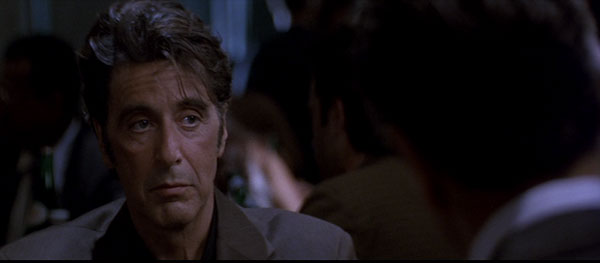Michael Mann’s epic tale of cops and robbers packs in enough story lines to make even the three-hour running time feel too brief. Released in 1995, Heat brings acting superstars Robert De Niro and Al Pacino together on screen for the first time. They both appeared in The Godfather Part II but in different time periods. Their only scene together (besides the brief finale) occurs at a coffee shop, and it reveals both actors at the top of their craft. Neither actor overplays the moment, which gives the scene a believable, naturalistic feeling. Following the themes of this marathon, I’m going to focus on the film’s three heists and what role they play in the overall story.
Heist #1: The Armored Car
Plenty of reviews have covered the plot of Heat, so I won't waste time describing the details up front. Instead, I’m going to jump right into the first heist, which occurs right at the beginning. The movie’s opening scene shows De Niro’s Neal McCauley strolling through a hospital and then stealing an ambulance. In a short period of time, we meet the other members of the gang — the pony-tailed Chris Shiherlis (Val Kilmer); Michael Cheritto (Tom Sizemore); Trejo (Danny Trejo); and Waingro (Kevin Cage), a new team member. With minimal dialogue, it’s clear that these guys are professionals, not your typical criminals. They’re aware of the police’s timetable of three minutes and act with brutal efficiency.
The professionalism of Neil’s crew is obvious compared to the wild card Waingro, who kills a cop for no reason and jeopardizes the score. The gang’s immediate response to kill the other cops shows that they can be vicious if necessary. The entire armored-car heist takes just over three minutes before they’re free and clear. Using a big-rig truck and well-timed explosives, they’re able to grab the prize and escape in time. The killing brings the Robbery Homicide division onto the scene, led by diehard Vincent Hanna (Al Pacino), who recognizes an equally competent opponent in Neil. His description of the crew’s skills for his fellow cops also helps us understand their abilities. As the audience, we’ve barely met these guys, but Mann clearly identifies the even playing field between the criminals and the police.
Heist #2: The Platinum
The least important heist of the three is the middle one, but it reveals more essential details about Neil’s approach. He doesn’t realize they’re being tailed by Vincent’s group, so this break-in will likely be the end. While Chris cuts through the safe to grab their target, Neil stands watch outside the nondescript building. Again, they work in near silence and don’t waste time on chit-chat. The only saving grace for them is a clumsy cop, who makes a noise and alerts Neil. Without even considering if the sound indicates trouble, he calls off the heist and they walk. It’s a lucky break, but Neil’s immediate decision to give up the loot shows his strict discipline. The rewards aren’t worth risking everything. This moment also turns the table on the cops, who won’t be able to sneak up on Neil’s crew again. The entire scene only lasts four minutes, but it again shows Mann’s masterful storytelling.
Heist #3: The Bank
The first two heists were just a precursor to the ultimate score, which could generate more than $12 million. After discovering the cops’ presence, Neil seriously considers dropping the plan, which would fit with his approach. However, the bank is worth the risk, and this deviation leads them to ultimate disaster. Looking at the actual robbery, it again shows their professional approach. From the time they don the masks and take charge, less than five minutes pass before they’re exiting the bank. It’s a brilliant exercise in efficiency, but even that can’t deliver complete success. Once the cops arrive ready to stop them, a massive shootout on the streets of Los Angeles raises the intensity to a new level.
This shootout works better than your typical gunfight because we’re engaged in both Neil and Vincent’s stories. It’s a great action sequence, and the higher stakes makes for an even more energetic showdown. This battle would be the highlight of many films, but the sequence takes place only two-thirds of the way through Heat. Instead of feeling let down afterwards, we’re still interested in the aftermath of the botched heist. Mann gives nearly all of the characters a chance to shine, even as they’re scrambling to avoid capture. During the final chase between Neil and Vincent, many viewers (including this one) are rooting for the criminal to escape. Neil’s actions have brought about death and destruction, but we’ve become interested enough in his story to hope for a positive conclusion for the character.
Note: This post contains affiliate links. Making any purchase through those links supports this site. See full disclosure.





You have done it again!!
ReplyDeleteI have jusr re-added this to my LOVEFiLM list. I want to see it again now. You break it down so well I am hooked on it!!
Thanks for writing this up. Great idea for a post!! Brilliant
Thanks! Heat has been one of my favorites for a while, but I hadn't sat down to watch it in years. It was a lot of fun to check it out again for this post.
ReplyDeleteI don't think any guy worth his salt could say he was less than entranced by the third heist sequence. It's easily the best ever made IMO.
ReplyDeleteCastor, you're definitely right that the third heist and big shootout is an amazing sequence. It holds up really well 16 years later and remains at the top.
ReplyDelete